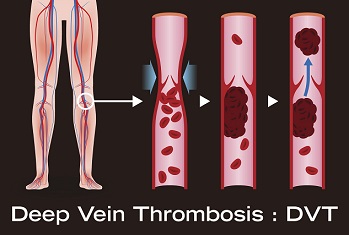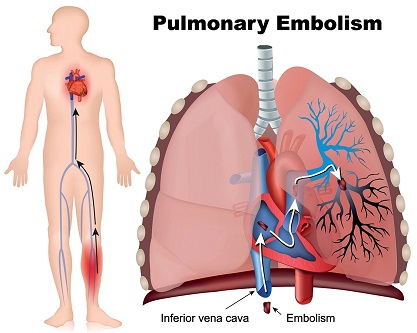Swedish Study Validates That Post-COVID Individuals Are At A Higher Risk For Deep Vein Thrombosis, Pulmonary Embolism And Bleeding!
Source: Thromboembolism-COVID-19 Apr 09, 2022 3 years, 8 months, 6 days, 2 hours, 50 minutes ago
Thromboembolism-COVID-19: A new study led by researchers from Umeå University-Sweden has confirmed earlier studies indicating that most Post-COVID individuals are at a higher risk for deep vein thrombosis, pulmonary embolism and bleeding! The study findings showed that irrespective of initial asymptomatic or symptomatic manifestations at initial infection, there was an increased risk of deep vein thrombosis (a blood clot in the leg) up to three months after COVID-19 infection, pulmonary embolism (a blood clot in the lung) up to six months, and a bleeding event up to two months.

The self-controlled case series and matched cohort study was designed to quantify the risk of deep vein thrombosis, pulmonary embolism, and bleeding after COVID-19.
The
Thromboembolism-COVID-19 study involved 1 057 174 people from the National registries in Sweden who tested positive for SARS-CoV-2 between 1 February 2020 and 25 May 2021 in Sweden, matched on age, sex, and county of residence to 4 076 342 control participants.
Self-controlled case series and conditional Poisson regression were used to determine the incidence rate ratio and risk ratio with corresponding 95% confidence intervals for a first deep vein thrombosis, pulmonary embolism, or bleeding event. In the self-controlled case series, the incidence rate ratios for first time outcomes after COVID-19 were determined using set time intervals and the spline model. The risk ratios for first time and all events were determined during days 1-30 after covid-19 or index date using the matched cohort study, and adjusting for potential confounders (comorbidities, cancer, surgery, long term anticoagulation treatment, previous venous thromboembolism, or previous bleeding event).
The study findings alarmingly showed that compared with the control period, incidence rate ratios were significantly increased 70 days after COVID-19 for deep vein thrombosis, 110 days for pulmonary embolism, and 60 days for bleeding. In particular, incidence rate ratios for a first pulmonary embolism were 36.17 (95% confidence interval 31.55 to 41.47) during the first week after covid-19 and 46.40 (40.61 to 53.02) during the second week. Incidence rate ratios during days 1-30 after covid-19 were 5.90 (5.12 to 6.80) for deep vein thrombosis, 31.59 (27.99 to 35.63) for pulmonary embolism, and 2.48 (2.30 to 2.68) for bleeding. Similarly, the risk ratios during days 1-30 after COVID-19 were 4.98 (4.96 to 5.01) for deep vein thrombosis, 33.05 (32.8 to 33.3) for pulmonary embolism, and 1.88 (1.71 to 2.07) for bleeding, after adjusting for the effect of potential confounders.
The rate ratios were highest in patients with critical covid-19 and highest during the first pandemic wave in Sweden compared with the second and third waves. In the same period, the absolute risk among patients with covid-19 was 0.039% (401 events) for deep vein thrombosis, 0.17% (1761 events) for pulmonary embolism, and 0.101% (1002 events) for bleeding.
The study findings suggest that COVID-19 is a risk factor for deep vein thrombosis, pulmonary embolism, and bleeding. These results could impact recommendations on diagnostic and prophylactic strategies against venous thromboembolism after COVID-19.
The study findings were published in the peer reviewed Brit
ish Medical Journal.
https://www.bmj.com/content/377/bmj-2021-069590
The study team says these results support measures to prevent thrombotic events (thromboprophylaxis), especially for high risk patients, and strengthen the importance of vaccination against COVID-19.
To date, it is well known that COVID-19 increases the risk of serious blood clots (known as venous thromboembolism or VTE), but less evidence exists on the length of time this risk is increased, if risk changed during the pandemic waves, and whether COVID-19 also increases the risk of major bleeding.
In order to address these uncertainties, the study team set out to measure the risk of deep vein thrombosis, pulmonary embolism, and bleeding after COVID-19.
Utilizing national registries in Sweden, the study team identified more than one million individuals with confirmed SARS-CoV-2 infection (the virus responsible for covid-19) between 1 February 2020 and 25 May 2021, matched by age, sex, and county of residence to more than four million people who had not had a positive SARS-CoV-2 test result.
The study team then performed two analyses: in the first, they calculated the rates of deep vein thrombosis, pulmonary embolism, and bleeding in COVID-19 individuals during a control period (before and long after COVID-19 diagnosis) and compared it to the rates in different time intervals after COVID-19 diagnosis (days 1-7, 8-14, 15-30, 31-60, 61-90, and 91-180).
Subsequently, in the second analysis, the study team calculated the rates of deep vein thrombosis, pulmonary embolism, and bleeding during the period 1-30 days after COVID-19 diagnosis in the COVID-19 group and compared them to the corresponding rates in the control group.
 The study findings showed that compared with the control period, risks were significantly increased 90 days after covid-19 for deep vein thrombosis, 180 days for pulmonary embolism, and 60 days for bleeding.
Importantly, after taking account of a range of potentially influential factors, the study team found a fivefold increase in risk of deep vein thrombosis, a 33-fold increase in risk of pulmonary embolism, and an almost twofold increase in risk of bleeding in the 30 days after infection!
Shockingly, this in absolute terms means that a first deep vein thrombosis occurred in 401 patients with COVID-19 (absolute risk 0.04%) and 267 control patients (absolute risk 0.01%).
Also, a first pulmonary embolism event occurred in 1,761 patients with COVID-19 (absolute risk 0.17%) and 171 control patients (absolute risk 0.004%), and a first bleeding event occurred in 1,002 patients with COVID-19 (absolute risk 0.10%) and 1,292 control patients (absolute risk 0.04%).
The study findings showed that compared with the control period, risks were significantly increased 90 days after covid-19 for deep vein thrombosis, 180 days for pulmonary embolism, and 60 days for bleeding.
Importantly, after taking account of a range of potentially influential factors, the study team found a fivefold increase in risk of deep vein thrombosis, a 33-fold increase in risk of pulmonary embolism, and an almost twofold increase in risk of bleeding in the 30 days after infection!
Shockingly, this in absolute terms means that a first deep vein thrombosis occurred in 401 patients with COVID-19 (absolute risk 0.04%) and 267 control patients (absolute risk 0.01%).
Also, a first pulmonary embolism event occurred in 1,761 patients with COVID-19 (absolute risk 0.17%) and 171 control patients (absolute risk 0.004%), and a first bleeding event occurred in 1,002 patients with COVID-19 (absolute risk 0.10%) and 1,292 control patients (absolute risk 0.04%).
Interestingly, it was found that risks were highest in patients with more severe COVID-19 and during the first pandemic wave compared with the second and third waves, which the researchers say could be explained by improvements in treatment and vaccine coverage in older patients after the first wave.
Alarmingly, even among mild, non-hospitalized COVID-19 patients, the study team found increased risks of deep vein thrombosis and pulmonary embolism.
As this is an observational study, the study team cannot establish cause, and they acknowledge several limitations which might have affected their findings. For example, VTE may have been underdiagnosed in patients with COVID-19, testing for COVID-19 was limited, especially during the first pandemic wave, and information on vaccination was not available.
The study findings however were largely consistent after further analyses, and are in line with similar studies on the association between COVID-19 and thromboembolic events, suggesting that they withstand scrutiny.
The study team as such say their findings suggest that COVID-19 is an independent risk factor for deep vein thrombosis, pulmonary embolism, and bleeding, and that the risk of these outcomes is increased for three, six, and two months after COVID-19, respectively.
The study team told Thailand
Medical News, "Our study findings arguably support thromboprophylaxis to avoid thrombotic events, especially for high risk patients, and strengthen the importance of vaccination against COVID-19."
Researchers at the University of Glasgow in an accompanying editorial, point out that despite the potential for new variants of concern, most governments are removing restrictions and shifting their focus to determining how best to "live with COVID." However, they warned that this study "reminds us of the need to remain vigilant to the complications associated with even mild SARS-CoV-2 infection, including thromboembolism."
https://www.bmj.com/content/377/bmj.o817
For more on
Thromboembolism-COVID-19, keep on logging to Thailand Medical News.

